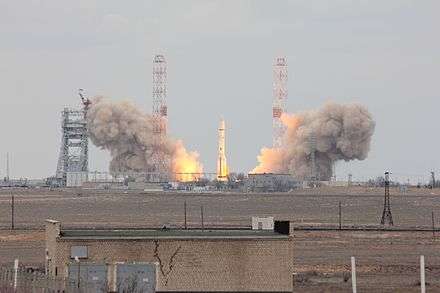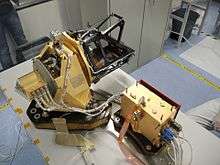ExoMars Trace Gas Orbiter
|
Artist's illustration of ExoMars 2016 | |||||||||||
| Mission type | Mars orbiter | ||||||||||
|---|---|---|---|---|---|---|---|---|---|---|---|
| Operator | ESA · Roscosmos | ||||||||||
| COSPAR ID | 2016-017A | ||||||||||
| SATCAT no. | 41388 | ||||||||||
| Website | http://exploration.esa.int/jump.cfm?oid=46475 | ||||||||||
| Mission duration |
Planned: 7 years[1][2] Elapsed: 1 year, 5 months, 1 day | ||||||||||
| Spacecraft properties | |||||||||||
| Manufacturer | Thales Alenia Space | ||||||||||
| Launch mass | 3,755 kg (8,278 lb)[3] | ||||||||||
| Payload mass |
Instruments: 113.8 kg (251 lb)[3] Schiaparelli: 577 kg (1,272 lb)[3] | ||||||||||
| Dimensions | 3.2 × 2 × 2 m (10.5 × 6.6 × 6.6 ft)[3] | ||||||||||
| Power | ~2000 W[3] | ||||||||||
| Start of mission | |||||||||||
| Launch date | 14 March 2016, 09:31 UTC[4] | ||||||||||
| Rocket | Proton-M/Briz-M | ||||||||||
| Launch site | Baikonur 200/39 | ||||||||||
| Contractor | Khrunichev | ||||||||||
| Orbital parameters | |||||||||||
| Reference system | Areocentric | ||||||||||
| Regime | Circular | ||||||||||
| Eccentricity | 0 | ||||||||||
| Periareion | 400 km (250 mi) | ||||||||||
| Apoareion | 400 km (250 mi) | ||||||||||
| Inclination | 74 degrees | ||||||||||
| Period | 2 hours | ||||||||||
| Epoch | planned | ||||||||||
| Mars orbiter | |||||||||||
| Orbital insertion | 19 October 2016, 15:24 UTC[5] | ||||||||||
| |||||||||||
|
ExoMars programme | |||||||||||
The ExoMars Trace Gas Orbiter (TGO) is a collaborative project between the European Space Agency (ESA) and Roscosmos that sent an atmospheric research orbiter and the Schiaparelli demonstration lander to Mars in 2016 as part of the European-led ExoMars programme.[6][7][8]
The Trace Gas Orbiter delivered the Schiaparelli lander and will start atmospheric mapping in 2017. A key goal is to gain a better understanding of methane (CH
4) and other trace gases present in the Martian atmosphere that could be evidence for possible biological activity. The programme will follow with the Surface Science Platform and the ExoMars rover in 2020,[9] which will search for biomolecules and biosignatures; the TGO will operate as the communication link for the 2020 ExoMars rover and surface science platform and provide communication for other Mars surface probes with Earth. The lander's radio signal was lost during the descent through the Mars atmosphere and later the lander was confirmed to have crashed.[10]
History
Investigations with space and Earth-based observatories have demonstrated the presence of a small amount of methane on the atmosphere of Mars that seems to vary with location and time.[11][12][13] This may indicate the presence of microbial life on Mars, or a geochemical process such as volcanism or hydrothermal activity.[14][15][16][17]
The challenge to discern the source of methane in the atmosphere of Mars prompted the independent planning by ESA and NASA of one orbiter each that would carry instruments in order to determine if its formation is of biological or geological origin,[18][19] as well as its decomposition products such as formaldehyde and methanol.
Origins
ExoMars Trace Gas Orbiter was born out of the nexus of ESA's Aurora programme ExoMars flagship and NASA's 2013 and 2016 Mars Science Orbiter (MSO) concepts.[20][21] It became a flexible collaborative proposal within NASA and ESA to send a new orbiter-carrier to Mars in 2016 as part of the European-led ExoMars mission.[8] On the ExoMars side, ESA authorized about half a billion Euros in 2005 for a rover and mini-station; eventually this evolved into being delivered by an orbiter rather than a cruise stage.[22]
Attempted collaboration with NASA
NASA's Mars Science Orbiter (MSO) was originally envisioned in 2008 as an all-NASA endeavour aiming for a late 2013 launch.[20][21] NASA and ESA officials agreed to pool resources and technical expertise and collaborate to launch only one orbiter.[23] The agreement, called the Mars Exploration Joint Initiative, was signed on July 2009 and proposed to use an Atlas rocket launcher instead of a Soyuz rocket, which significantly altered the technical and financial setting of the European ExoMars mission. Since the ExoMars rover was originally planned to be launched along with the TGO, a prospective agreement would require that the rover lose enough weight to fit aboard the Atlas launch vehicle with NASA's orbiter.[24] Instead of reducing the rover's mass, it was nearly doubled when the mission was combined with other projects to a multi-spacecraft programme divided over two Atlas V launches:[23][25] the ExoMars Trace Gas Orbiter (TGO) was merged into the project, carrying a meteorological lander planned for launch in 2016. The European orbiter would carry several instruments originally meant for NASA's MSO, so NASA scaled down the objectives and focused on atmospheric trace gases detection instruments for their incorporation in ESA's ExoMars Trace Gas Orbiter.[8][21][26]
Under the FY2013 budget President Barack Obama released on 13 February 2012, NASA terminated its participation in ExoMars due to budgetary cuts in order to pay for the cost overruns of the James Webb Space Telescope.[27] With NASA's funding for this project cancelled, most of ExoMars' plans had to be restructured.[28]
Collaboration with Russia
On 15 March 2012, the ESA's ruling council announced it would press ahead with its ExoMars program in partnership with the Russian space agency Roscosmos, which planned to contribute two heavy-lift Proton launch vehicles and an additional entry, descent and landing system to the 2020 rover mission.[29][30][31][32][33]
Under the collaboration proposal with Roscosmos, the ExoMars mission is split into two parts: the orbiter/lander mission in March 2016 that includes the TGO and a 2.4 m (7 ft 10 in) diameter stationary lander build by ESA named Schiaparelli;[34] this will be followed by the ExoMars rover mission in 2020[9] —also to be launched with a Russian Proton rocket.
Launch

The Trace Gas Orbiter and descent module Schiaparelli completed testing and were integrated to a Proton rocket at the Baikonur Cosmodrome in Kazakhstan in mid-January 2016.[35] The launch occurred at 09:31 UTC on 14 March 2016.[4] Four rocket burns occurred in the following 10 hours before the descent module and orbiter were released.[36] A signal from the spacecraft was received at 21:29 UTC that day, confirming that the launch was successful and the spacecraft were functioning properly.[37]
Shortly after separation from the probes, a Brazilian ground telescope recorded small objects in the vicinity of the Briz-M upper booster stage, suggesting that the Briz-M stage exploded a few kilometres away, without damaging the orbiter or lander.[38] Briefing reporters in Moscow, the head of Roscosmos denied any anomaly and made all launch data available for inspection.[39]
Status
The Schiaparelli lander separated from the TGO orbiter on 16 October 2016,[40] three days before it arrived on Mars, and entered the atmosphere at 21,000 km/h (13,000 mph; 5.8 km/s).[41] The lander's radio signal was lost during the descent through the atmosphere,[10][42] and as of 20 October 2016, the descent data are still being analysed.[43]
The TGO was injected into Mars orbit on 19 October 2016 and it will undergo several months of aerobraking to adjust its speed and manoeuvre into a 400 km (250 mi) high circular orbit above the planet, with science activities scheduled to begin in late 2017.[41]
Specifications

- Dimensions
- The central bus is 3.2 m × 2 m × 2 m (10.5 ft × 6.6 ft × 6.6 ft)[3]
- Propulsion
- 424 N (95 lbf) bi-propellant main engine, used for Mars Orbit Insertion and manoeuvres[3]
- Power
- 20 m2 (220 sq ft) solar arrays spanning 17.5 m (57 ft) tip-to-tip, and capable of rotating one degree; will generate about 2000 W of power at Mars[3]
- Batteries
- 2 modules of lithium-ion batteries with approximately 5100 watt hours total capacity to provide power during eclipses over the prime mission[3]
- Communication
- 2.2 m (7 ft 3 in) X band high-gain antenna with a two-axis pointing mechanism and 65 W RF travelling-wave tube amplifier to communicate with Earth[3]
- Electra UHF band transceivers with a single helical antenna to communicate with spacecraft at Mars[3]
- Thermal control
- Spacecraft yaw axis control to ensure the three faces containing the science payload remain cold
- Mass
- 3,755 kg (8,278 lb), wet mass of the orbiter[3]
- 4,332 kg (9,550 lb), wet mass of the orbiter plus Schiaparelli lander[3]
- Payload
- 113.8 kg (251 lb) of science instruments[3]
Science

The TGO separated from the ExoMars Schiaparelli demonstration lander and would have provided it with telecommunication relay for 8 Martian solar days (sols) after landing. Then the TGO will gradually aerobrake for seven months into a more circular orbit for science observations and will provide communications relay for the ExoMars rover to be launched in 2020, and will continue serving as a relay satellite for future landed missions until 2022.[2]
The FREND instrument will map hydrogen levels to a maximum depth of 1 m (3 ft 3 in) beneath the Martian surface.[44][45] Locations where hydrogen is found may indicate water-ice deposits, which could be useful for future crewed missions.
Particularly, the mission will characterise spatial, temporal variation, and localisation of sources for a broad list of atmospheric trace gases. If methane (CH
4) is found in the presence of propane (C
3H
8) or ethane (C
2H
6), that will be a strong indication that biological processes are involved.[46] However, if methane is found in the presence of gases such as sulfur dioxide (SO
2), that would be an indication that the methane is a byproduct of geological processes.[47]
- Detection

The nature of the methane source requires measurements of a suite of trace gases in order to characterise potential biochemical and geochemical processes at work. The orbiter has very high sensitivity to (at least) the following molecules and their isotopomers:
water (H
2O), hydroperoxyl (HO
2), nitrogen dioxide (NO
2), nitrous oxide (N
2O), methane (CH
4), acetylene (C
2H
2), ethylene (C
2H
4), ethane (C
2H
6), formaldehyde (H
2CO), hydrogen cyanide (HCN), hydrogen sulfide (H
2S), carbonyl sulfide (OCS), sulfur dioxide (SO
2), hydrogen chloride (HCl), carbon monoxide (CO) and ozone (O
3). Detection sensitivities are at levels of 100 parts per trillion, improved to 10 parts per trillion or better by averaging spectra which could be taken at several spectra per second.[48]
- Characterisation
- Spatial and temporal variability: latitude–longitude coverage multiple times in a Mars year to determine regional sources and seasonal variations (reported to be large, but still controversial with present understanding of Mars gas-phase photochemistry.)
- Correlation of concentration observations with environmental parameters of temperature, dust and ice aerosols (potential sites for heterogeneous chemistry.)
- Localisation
- Mapping of multiple tracers (e.g., aerosols, water vapour, CO, CH
4) with different photochemical lifetimes and correlations helps constrain model simulations and points to source/sink regions. - To achieve the spatial resolution required to localise sources might require tracing molecules at parts-per-billion concentrations.
Payload

Like the Mars Reconnaissance Orbiter, the Trace Gas Orbiter is a hybrid science and telecom orbiter.[49] Its scientific payload mass is about 113.8 kg (251 lb) and consists of:[3][50]
- The Nadir and Occultation for Mars Discovery (NOMAD) has two infrared and one ultraviolet spectrometer channels. Developed by Belgium.
- The Atmospheric Chemistry Suite (ACS) has three infrared spectrometer channels.[51][52] Developed by Russia.
- NOMAD and ACS will provide the most extensive spectral coverage of Martian atmospheric processes so far.[49][53] Twice per orbit, at local sunrise and sunset, they will be able to observe the Sun as it shines through the atmosphere. Detection of atmospheric trace species at the parts-per-billion (ppb) level will be possible.
- The Colour and Stereo Surface Imaging System (CaSSIS) is a high-resolution, 4.5 m per pixel (15 ft/pixel), colour stereo camera for building accurate digital elevation models of the Martian surface. It will also be an important tool for characterising candidate landing site locations for future missions. Developed by Switzerland.
- The Fine-Resolution Epithermal Neutron Detector (FREND) is a neutron detector that can provide information on the presence of hydrogen, in the form of water or hydrated minerals, in the top 1 m (3 ft 3 in) of the Martian surface.[52] Developed by Russia.
Relay telecommunications

Due to the challenges of entry, descent and landing, Mars landers are highly constrained in mass, volume and power. For landed missions, this places severe constraints on antenna size and transmission power, which in turn greatly reduce direct-to-Earth communication capability in comparison to orbital spacecraft. As an example, the capability downlinks on Spirit and Opportunity rovers have only 1⁄600 the capability of the Mars Reconnaissance Orbiter downlink. Relay communication addresses this problem by allowing Mars surface spacecraft to communicate using higher data rates over short-range links to nearby Mars orbiters, while the orbiter takes on the task of communicating over the long-distance link back to Earth. This relay strategy offers a variety of key benefits to Mars landers: increased data return volume, reduced energy requirements, reduced communications system mass, increased communications opportunities, robust critical event communications and in situ navigation aid.[54] NASA provided an Electra telecommunications relay and navigation instrument to assure communications between probes and rovers on the surface of Mars and controllers on Earth.[55] The TGO will provide the ExoMars rover with a telecommunication relay; it will also serve as a relay satellite for future landed missions until 2022.[2]
See also
References
- ↑ "ExoMars Trace Gas Orbiter and Schiaparelli Mission (2016)". European Space Agency. 16 October 2016. Retrieved 24 October 2016.
- 1 2 3 Allen, Mark A.; Witasse, Olivier (2011). 2016 ESA/NASA ExoMARS/Trace Gas Orbiter. Mars Exploration Program Assessment Group. 15–16 June 2011. Lisbon, Portugal.
- 1 2 3 4 5 6 7 8 9 10 11 12 13 14 15 "ExoMars Trace Gas Orbiter (TGO)". European Space Agency. 12 July 2012. Retrieved 8 March 2014.
- 1 2 Amos, Jonathan (14 March 2016). "Mars methane mission lifts off". BBC. Retrieved 14 March 2016.
- ↑ Nowakowski, Tomasz (20 October 2016). "Lost on Mars: Schiaparelli lander falls silent shortly before touchdown". Spaceflight Insider. Retrieved 24 October 2016.
- ↑ Chang, Kenneth (19 October 2016). "ExoMars Mission to Join Crowd of Spacecraft at Mars". New York Times. Retrieved 19 October 2016.
- ↑ Vago, J. L. (10 September 2009), "Mars Panel Meeting" (PDF), Planetary Science Decadal Survey (PDF), Arizona State University, Tempe (US): ESA
- 1 2 3 Mustard, Jack (9 July 2009). "MEPAG Report to the Planetary Science Subcommittee" (PDF). Mars Exploration Program Analysis Group. p. 3.
- 1 2 "Second ExoMars mission moves to next launch opportunity in 2020" (Press release). ESA. 2 May 2016. Retrieved 2 May 2016.
- 1 2 Amos, Jonathan (19 October 2016). "Fears grow for European Schiaparelli Mars lander". BBC News. Retrieved 20 October 2016.
- ↑ "Mars Trace Gas Mission". MEPAG. 10 September 2009.
- ↑ Mumma, Michael J.; Villanueva, Gerónimo L.; Novak, Robert E.; Hewagama, Tilak; Bonev, Boncho P.; Disanti, Michael A.; Mandell, Avi M.; Smith, Michael D. (20 February 2009). "Strong Release of Methane on Mars in Northern Summer 2003" (PDF). Science. 323 (5917): 1041–1045. Bibcode:2009Sci...323.1041M. PMID 19150811. doi:10.1126/science.1165243.
- ↑ Hand, Eric (21 October 2008). "Plumes of methane identified on Mars" (PDF). Nature News. Retrieved 2 August 2009.
- ↑ "Making Sense of Mars' Methane". Astrobio.net. June 2008.
- ↑ Steigerwald, Bill (15 January 2009). "Martian Methane Reveals the Red Planet is not a Dead Planet". NASA's Goddard Space Flight Center. NASA. Retrieved 24 January 2009.
- ↑ Howe, K. L.; Gavin, P.; Goodhart, T.; Kral, T. A. (2009). Methane Production by Methanogens in Perchlorate-Supplemented Media. (PDF). 40th Lunar and Planetary Science Conference.
- ↑ Levin, Gilbert V.; Straat, Patricia Ann (3 September 2009). "Methane and life on Mars". Proc. SPIE. Proceedings of SPIE. 7441 (74410D): 74410D. doi:10.1117/12.829183.
- ↑ Rincon, Paul (9 July 2009). "Agencies outline Mars initiative". BBC News. Retrieved 26 July 2009.
- ↑ "NASA orbiter to hunt for source of Martian methane in 2016". Thaindian News. 6 March 2009. Retrieved 26 July 2009.
- 1 2 Smith, Michael (10 September 2009). "Mars Trace Gas Mission: Science Rationale & Concept" (PDF). Presentation to the NRC Decadal Survey Mars Panel.
- 1 2 3 Zurek, R.; Chicarro, A. (29 July 2009). "Report to MEPAG on the ESA-NASA Joint Instrument Definition Team (JIDT) for the Proposed 2016 Orbiter-Carrier" (PDF). NASA. Archived from the original (PDF) on 30 July 2009.
- ↑ "Brief ExoMars Project History". Spaceflight101.com. 2016. Retrieved 12 November 2016.
- 1 2 Taverna, Michael A. (19 October 2009). "ESA Proposes Two ExoMars Missions". Aviation Week. Retrieved 30 October 2009.
- ↑ "NASA Could Take Role in European ExoMars Mission". Space News. 19 June 2009.
- ↑ Amos, Jonathan (12 October 2009). "Europe's Mars plans move forward". BBC News. Retrieved 12 October 2009.
- ↑ "ExoMars Trace Gas Orbiter (TGO)". European Space Agency. 6 January 2012. Retrieved 19 March 2012.
- ↑ Kremr, Ken (1 February 2012). "Experts React to Obama Slash to NASA's Mars and Planetary Science Exploration". Universe Today. Retrieved 18 February 2012.
- ↑ Whewell, Megan (15 February 2012). "Have Europe's Martian exploration plans been derailed by America?". MSN News. Retrieved 15 February 2012.
- ↑ Svitak, Amy (16 March 2012). "Europe Joins Russia on Robotic ExoMars". Aviation Week. Retrieved 16 March 2012.
- ↑ De Selding, Peter B. (15 March 2012). "ESA Ruling Council OKs ExoMars Funding". Space News. Retrieved 16 March 2012.
- ↑ "NASA drops ExoMars missions in 2013 budget". Optics. 15 February 2012. Retrieved 15 February 2012.
- ↑ "Spacewatch: Uncertainties for ExoMars". The Guardian. 16 March 2012.
- ↑ Amos, Jonathan (15 March 2012). "Europe still keen on Mars missions". BBC News. Retrieved 16 March 2012.
- ↑ "ExoMars". Russian Space Web. Retrieved 22 October 2013.
- ↑ "ExoMars 2016 Schiaparelli Module in Baikonur". ESA. SpaceRef. 6 January 2016. Retrieved 6 January 2016.
- ↑ Gibney, Elizabeth (11 March 2016). "Mars launch to test collaboration between Europe and Russia". Nature. 531: 288–299. PMID 26983519. doi:10.1038/nature.2016.19547. Retrieved 14 March 2016.
- ↑ "ExoMars on its way to solve the Red Planet's mysteries". ESA. 14 March 2016. Retrieved 15 March 2016.
- ↑ King, Bob (24 March 2016). "ExoMars Mission Narrowly Avoids Exploding Booster". Universe Today. Retrieved 25 March 2016.
- ↑ de Selding, Peter B. (5 April 2016). "Roscosmos gives detailed rebuttal to reports of Proton ExoMars launch anomaly". Space News. Retrieved 5 April 2016.
- ↑ Malik, Tariq (16 October 2016). "European Mars Lander Separates From Mothership, Takes Aim at Red Planet". Space.com. Retrieved 16 October 2016.
- 1 2 Aron, Jacob (7 March 2016). "ExoMars probe set to sniff out signs of life on the Red Planet". New Scientist. Retrieved 7 March 2016.
- ↑ Chan, Sewell (20 October 2016). "No Signal From Mars Lander, but European Officials Declare Mission a Success". New York Times. Retrieved 20 October 2016.
- ↑ "Schiaparelli descent data: decoding underway". ESA. 20 October 2016. Retrieved 20 October 2016.
- ↑ "ExoMars 2016". National Space Science Data Center. NASA. Retrieved 15 March 2016.
- ↑ Gannon, Megan (14 March 2016). "The Science of ExoMars: New Mission to Hunt for Mars Life". Space.com. Retrieved 16 March 2016.
- ↑ Montmessin, F. "Atmospheric Chemistry Suite: Science Overview" (PDF). LATMOS CNRS, France. p. 44. Retrieved 14 March 2016.
Determining the origin of methane on Mars can only be addressed by looking at methane isotopologues and at higher alkanes (ethane, propane).
- ↑ McKie, Robin (20 February 2016). "'Giant nose in the sky’ ready for lift-off in mission to sniff out traces of life on Mars". The Guardian. Retrieved 21 February 2016.
- ↑ Vandaele, A. C.; et al. "NOMAD, a spectrometer suite for nadir and solar occultation observations on the ExoMars Trace Gas Orbiter" (PDF). Institut des NanoSciences de Paris. Retrieved 4 September 2015.
- 1 2 Vago, J.; et al. (August 2013). "ExoMars, ESA’s next step in Mars exploration" (PDF). ESA Bulletin (155). pp. 12–23.
- ↑ "ExoMars Trace Gas Orbiter Instruments". ESA. 20 February 2014. Retrieved 8 March 2014.
- ↑ Zakutnyaya, Olga (25 November 2012). "Europe to invest 12 bln euros in a new space Odyssey". Space Daily.
- 1 2 "Russia to Construct Landing Pad for Russian-European "ExoMars-2018" Space Mission". RIA Novosti. Russia. 4 August 2014. Retrieved 5 August 2014.
- ↑ Amos, Jonathan (18 June 2013). "Europe". BBC News. Retrieved 18 June 2013.
- ↑ Edwards, Jr., Charles D.; Banerdt, William B.; Beaty, David W.; Tamppari, Leslie K.; Zurek, Richard W. (15 September 2009). "Relay Orbiters for Enhancing and Enabling Mars In Situ Exploration" (PDF). Mars Exploration Program Analysis Group.
- ↑ De Selding, Peter B. (26 September 2012). "U.S., Europe Won't Go It Alone in Mars Exploration". Space News. Retrieved 27 September 2012.
External links
- ExoMars Trace Gas Orbiter at ESA.int
- ESA ExoMars on Flickr


.jpg)



.jpg)
.jpg)

.jpg)
